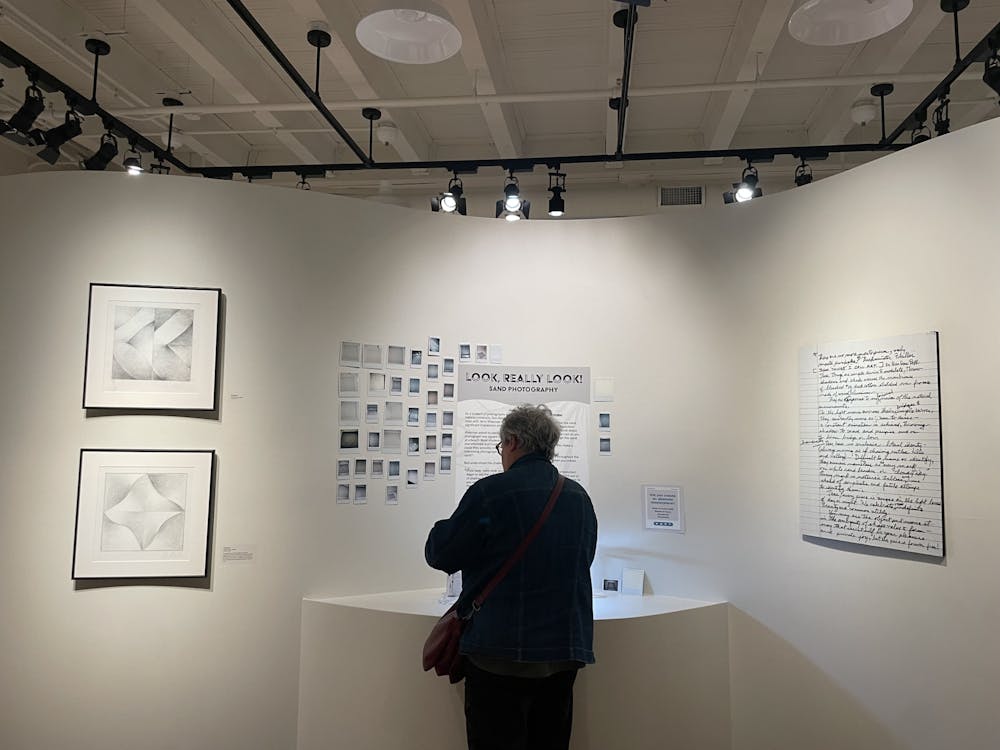IU alumnus Don Gene Bell’s lifetime of artwork fills the walls of the IU’s University Collections at the McCalla School gallery as visitors walk through the physical representations of his creativity. Bell passed away in September 2020 and his art was recovered from Tucson, Arizona by Kathryn Chattin, director of Campus Art and associate director of University Collections at McCalla, in the summer of 2022.
Bell studied design at IU, then became a professor and administration member of the department of art and art history at SUNY-Binghamton from 1968-1997.
Bell’s art had been stored at a collaborative art studio, which he and his partner, Bob Varga, founded in 1997. Varga wanted to preserve Bell’s art pieces, so he donated them to IU.
Chattin said University Collections is an overarching group at IU that stores and collects art donated to the university. The collections are housed at the McCalla School building on campus.
At first, her and her team were planning to only collect Bell’s stretched canvas pieces, however, she said after being shown more of the pieces he created, they realized his art work reached other genres. His artwork includes book cover illustrations, watercolor paintings, sketches of cats and paintings of the human form.
They ended up bringing around 200 pieces of Bell’s work back to Bloomington. Chattin said when deciding what artworks to put up in the gallery, she and her team thought of what would be important to Varga and Bell.
Many of Bell's paintings were of the landscapes in Arizona, shades of orange mixed together with a few stand out shades of green for trees. A couple of special paintings were also displayed: Bell’s portrait of Varga, and Varga’s portrait of Bell.
Chattin said that art is a way for an artist to live on, especially when put into a gallery or archived at places like IU.
“It serves a really wonderful purpose, an extension of their life,” she said.
When the gallery reception began at 5 p.m., an elderly couple, Jo and Steve Ham, walked through the door into the space that held Bell's past. Jo and Steve got married while studying at IU and are now alumni.
Though they are retired now, the pair enjoys the arts experience offered at IU, such as music, museums and art galleries like Bell’s. Something that stood out to the Hams was the variety of artwork Bell was able to create.
“This is a very unique thing. It’s interesting and I love the variety,” Jo said.
When Bell was in a class at IU, he was assigned to take a photo of a one foot square of sand and was inspired to try and recreate the ways that sand and wind mix, especially in a desert setting.
He decided to stretch canvases over wooden circular structures to replicate the ripples of sand in the photos. Some had wooden structures poking through the smooth white surface to represent wood sticking out of sand. Others had sloping dips to represent the ripples of dunes.
In a corner of the exhibit, there were sketchbooks and notes of Bell’s, showcasing the creative process of these canvas pieces. Math calculations and diameter measurements in his handwriting mix with erased lines from his drafting stages, a representation of his artistic mind.
Standing across from the stretched canvases was a curved wall in the center of the exhibit, made to represent the sand movements that inspired much of Bell’s work. Brian Woodman, director of the McCalla School and associate director of the University Collections at McCalla, took part in designing the wall.
It was the first time Woodman put together a curved wall at the McCalla School. Sand shapes that Bells recreated with his canvas stretches inspired Woodman and his team to create the wall shape. He said that art finds ways to showcase itself in many forms, whether or not it has to do with sculpting or mathematical calculations, which were both used in the shaping of the wall.
“We like the fact that we can have art intersect with lots of different subjects,” Woodman said.
In the curve of the wall, there was an interactive art display that had a square foot of sand, wooden tools and polaroid pictures for visitors to draw their own patterns in the sand and take a picture of it. The display allows participants to use their own artistic expressions to recreate what Bell was so often inspired by throughout his lifetime.
Two friends, Cindy Beaulé and Emily Jackson, Bloomington residents who work at WFHB Community Radio, tinkered with the polaroid cameras, using a few of the tools to draw patterns in the square of sand in front of them. They expressed their appreciation for a building like the McCalla School to showcase artwork like Bell’s.
“The reaching out back and forth is a great thing about the whole world of art,” Jackson said.
Beaulé, an IU alum, said she appreciated Bell’s ability to take simple things and creatively express them as art, specifically sharing appreciation for the gallery title, “These Things I Call Art.”
On one of the walls, a sentence written in Bell’s handwriting, reads, “There are no more masterpieces, just master principles.”
Chattin said that many artists throughout their lifetimes may worry about whether or not their art will be remembered. Bell's exhibit, “These Things I Call Art,” will stay up until the summer of 2024, continuing to allow others to witness his creative processes and even take part in the simple things which he found to be art.




